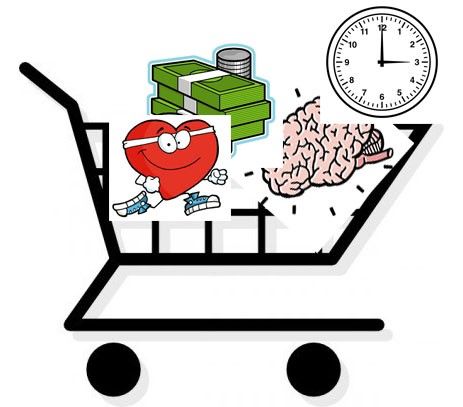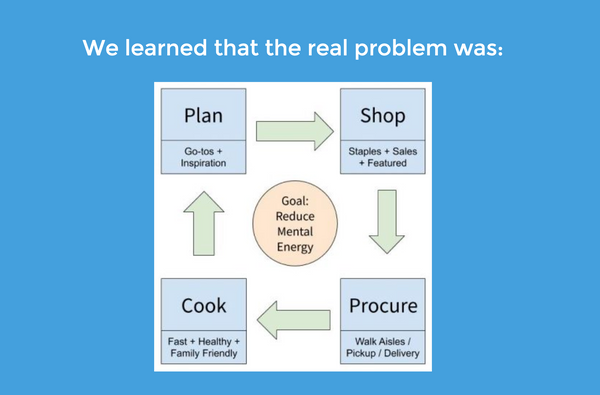Exploring the grocery industry’s underappreciated user need
I’ve been working for online food startups for the last 5 years, a short time period in most industries, but a lifetime in the burgeoning online grocery world. Throughout that roller coaster ride, I’ve learned all sorts of lessons about building digital products, the advantages & limitations of eCommerce, and the peculiarities of the grocery industry.
I plan to do more writing about these lessons this coming year, but wanted to start that process off by sharing an internal blog post I wrote at Relay Foods (a now defunct online grocer in the Mid-Atlantic region of the US) at the beginning of my journey into this space. I’m including it word for word because even though I wrote it in 2013, it’s amazing to me that the core of its message still holds true today. That is, it’s my belief that many people in the grocery industry don’t truly appreciate how important the concept of mental energy is to the happiness & health of their users, and as a result, to the success of their businesses. There is a lot more to come on this topic, but for now, enjoy 2013 Jeff’s thoughts — warts and all!
Hello my fellow Relayers! On the eve of our very first TV commercial (🎊), I wanted to share some thoughts I had upon reading an eye opening book called The American Way of Eating by Tracie McMillan. She chronicles her misadventures working in various parts of the US food system, and while I promise not to ruin most of the fun stories, I will say that one of them involves several hundred pounds of moldy asparagus in a Walmart warehouse. Suffice to say, I think it’s a should-read for all American grocery shoppers, and a must-read for folks like us! In particular, there’s a core concept she explores that I think may be crucial to Relay’s growth; she didn’t name it so I will — The Grocery Formula— which might be visually expressed as:

Or perhaps closer to this crappy clipart drawing I cobbled together:

Basically, at the heart of the grocery business is the idea that every grocery shopper is doing their damndest to strike some balance between these 4 variables: price, time, health, and mental energy. Because I’ve never been particularly strong at higher level math, let’s just go with the equation:
⬆️Health + ⬇️ Time + ⬇️Price + ⬇️Mental Energy = 😃
I imagine the corresponding thought process going something like this:
“Well, I know asparagus is expensive, but it’s supposed to be healthy. And I’m not even sure what to do with it. I might be able to figure it out, but who has the time. F*** it — where’s the frozen pizza aisle.”
Even the slightly more informed shoppers are still drowning in decisions:
“$2 more for organic?”, “make at home or pre-made?”, “low-fat or regular?”…
This is a fairly common problem coupled with the fairly universal (🤔) need to eat, which means a lot of potential customers in a system that is ripe (😒) for improvement! So why has a company like Relay Foods — with an enticing mission & well regarded product — had such a hard time with customer acquisition and retention?
Take my family’s story as an example of our ideal customer group — a couple with a young child at home who can afford to spend a bit more on food and is early to adopt new technologies. We knew of Relay Foods for a year before trying it, and even since we became a customer 2 years ago, we’ve gone through large periods of time when we didn’t use the service. There are all sorts of big and small reasons for those gaps, and frankly, the non-Relay employee side of my brain continues to grapple with my old-school grocery shopping tendencies. I imagine that some of you are in a similar boat — either you don’t use the Relay service (😅), or you do but have been frustrated by some aspect of it and/or are inconsistent in using it.
This doesn’t mean that Relay is not an awesome service built by lovely people. What it does seem to suggest is that despite being a powerhouse of time, health, and environmental savings, there’s something else holding people back. The easy-to-blame variable here is price, and I’d be naive to suggest that it wasn’t a prime factor. But, price alone doesn’t explain countless customers who shop at equally pricey spots like Whole Foods, Harris Teeter, Yes! Markets, etc., nor does it explain why customers with a Halloween sized grab-bag of Relay coupon candy at their fingertips very often only take one, if any, delicious bites.
So, really, what’s the problem?
What has been a lingering feeling of mine for a while, but crystallized upon reading this book, is that the fourth variable in the grocery formula, mental energy, is in fact the most crucial variable to the success of Relay Foods, and perhaps to the entire healthy food movement. Take away price, time, and health, and what you’re left with is the sheer fact that grocery shopping, and by extension meal planning and cooking, is complicated! Complicated to the point that many people would rather suffer through their current grocery routine than to endure any level of uncertainty or sense of “starting over” by trying something else. At Relay, I know we’ve talked about this before, but I’m not sure we fully appreciate the extent to which seemingly minute things can keep or turn customers away from us.
In fact, one explanation for the success of the bounty basket campaign from an acquisition perspective is that we are so drastically pulling the price lever in the grocery formula that it forces potential customers past their mental energy barrier. This is working pretty well to get new customers in, but we haven’t seen many of them return. I have to wonder whether they’re left with the “now what?” question, i.e. “that was neat, but back to the grocery store now that this box of produce is > $1.”
In a passage from the book, Tracie McMillan highlights the relative importance of mental energy in the grocery formula:
“Box meals don’t save us time any more than going out to eat does, and they don’t even save us money. What they do instead is remove the need to have to come up with a plan for dinner, something that’s easy when you’re a skilled cook — and bafflingly difficult when you’re not. The real convenience behind these convenience foods isn’t time or money, but that they remove one more bit of stress from our day.”
I think this points to two primary challenges for Relay:
1) Any attempt at pushing health foods must be accompanied by an even greater push towards aiding customers in understanding and using them. On our own, we’re certainly not going to be able to undo a disturbing trend towards less basic cooking, meal planning, and even personal budgeting & organizational skills, but we can educate as part of the easy to use tools and content we create, and through this, I believe we can really make a difference.
2) Online grocery shopping may require less mental energy than offline grocery shopping, BUT, the process of moving from offline to online requires a deceptively high amount of mental energy. We are attempting to change one of the most deeply ingrained behaviors there is, and the prospect of that change (regardless of perceived outcome) is stressful. We’ve been going to grocery stores all our lives; yes, it can be obnoxiously bright, loud, confusing, time-wasting, etc., but, hell, some of my earliest memories involve getting pushed around in the shopping cart, and don’t get me started on all the amazing smells! If we give customers any little reason to not choose Relay, even if it seems totally small and/or irrational, they’re going to take it, because the grocery store is what they’re used to, and it requires a known quantity of mental energy.
So what do we do?
If we can agree that these are the obstacles (they may not be!), then how do we systematically address them? Consider this advice:
“Actively seek out negative feedback about your company/product/idea, despite how painful it may be to hear.” — Elon Musk
This idea resonates with me because as humans we tend to shy away from subjects that might damage our ego. So, as producers of digital products, we probably underinvest in exploring these hidden negative reactions. And interestingly, in my informal experiences so far, I’ve found our consumers relunctant to share these reactions as well, I think because of how strongly our brand resonates (🍻). When I ask people about what they think about Relay, I get back lots of warm fuzzies — “Oh, Relay is great!” even if many of them have never used the service, or only done so sporadically. Only when I drill in a bit further (“Yes, yes, I agree that Relay is great, but let’s talk about why it’s not fitting into your routine…”), do I uncover a wealth of information. Personally, some of my not-always-rational reasons for not using Relay in the past have been:
Price
Is Relay actually affordable? Relay caters to a more affluent “yuppy” demographic so can it really reflect my values? Is better quality food really worth the extra cost? How do Relay’s prices compare to my go-to grocery store?
Time
How much time will Relay really save me? Grocery shopping at the store doesn’t take that long. If I have to go to the grocery for some items, I might as well go for all of them. I still have to wait at the pickup location, so is it that much more time saved than the grocery store? It doesn’t seem like I spend that much time meal planning / cooking / etc. I’m too busy to make time to even think about signing up for another service.
Health
What constitutes healthy food? Health food requires work. WTF does organic even MEAN!? Is local better, and why? Why should we care how my food gets to my plate? I can’t afford to eat healthily. I don’t have time to eat healthily.
Mental Energy
I’m not sure how to cook with all these things. I don’t know what to make for dinner this week. Searching amongst thousands of products without much direction is daunting. How do I see the ingredients and nutritional facts? How do I compare this product against another similar one? I forgot to make my Relay list. I was too busy to make my Relay list. I still have to make a written ingredient list, then translate into Relay. I was confused by the idea of, and then the interface to do Refill. I received too many substitutions. I received a particularly bad substitution, and I can’t make dinner for the dinner party tonight.
There are countless others (without even counting things like website bugs), and the thing is, it’s not our fault — we have done an absolutely spectacular job of getting this far (🙌). My ability to rattle those things off, despite being a happy customer, just shows how complicated a process grocery shopping is!
In reflecting on on the list above, I noticed that many of the reasons in the price/health/price categories can be expressed as reasons in the mental energy category. As an example, when someone is saying that Relay is not affordable, what they’re usually saying is “Relay is probably more expensive, and I’d rather go with that assumption than sit down to figure out whether Relay is more expensive across the board, and if so, how and why.”
A favorite UX (User Experience) designer of mine, Bret Victor, has a quote that is fitting in many situations, including this one:
“Technology changes quickly but people’s minds change slowly.”
That doesn’t mean we should just wait until people catch up on the fact that Relay is awesome, just that we should be as proactive as possible in figuring out the key reasons why it’s taking so damn long (😂).
If you’re still reading…
Thanks for making it this far (😴)! I hope that some of the above has resonated with you; I have no false delusion of brilliant insight — it’s just that with 1) a significant amount of resources being dedicated to customer acquisition, 2) a renewed effort on customer retention, and 3) a new website on the way, I think right now is a great time to engage in this mental energy conversation, and more specifically to experiment with a more formal approach in codifying the reasons that are keeping our customers from us. I’ve started an outline for what this process could look like, and will be reaching out to share more. In the meantime, I’d love to hear your thoughts and work with those of you who are excited about this idea!
I’m still very new here at Relay and feel so thankful that I get to work with such amazing people, and on such a purposeful mission. I know we’re going to be successful, and am looking forward to making it happen together (🎊💃💥💪🍻)!
Fast forward to 2019— although that last paragraph stings a bit to read now, I have fond memories reading back through this post. I hope you enjoyed it, and I’m looking forward to sharing more about this topic in the coming months…


